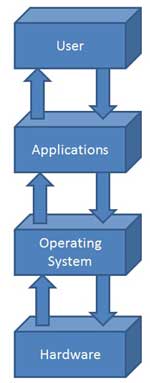Objectives of Operating System
- To make a computer system convenient to use in an efficient manner
- To hide the details of the hardware resources from the users
- To provide users a convenient interface to use the computer system
- To act as an intermediary between the hardware and its users and making it easier for the users to access and use other resources
- To manage the resources of a computer system
- To keep track of who is using which resource, granting resource requests, according for resource using and mediating conflicting requests from different programs and users
- To provide efficient and fair sharing of resources among users and programs

Characteristics of Operating System
- Memory Management -- keeps tracks of primary memory i.e. what part of it is in use by whom, what part is not in use etc. and allocates the memory when a process or program requests it.
- Processor Management -- allocates the processor(CPU) to a process and deallocates processor when it is no longer required.
- Device Management -- keeps track of all devices. This is also called I/O controller that decides which process gets the device, when, and for how much time.
- File Management -- allocates and de-allocates the resources and decides who gets the resources.
- Security -- prevents unauthorized access to programs and data by means of passwords and similar other techniques.
- Job accounting -- keeps track of time and resources used by various jobs and/or users.
- Control over system performance -- records delays between request for a service and from the system.
- Interaction with the operators -- The interaction may take place via the console of the computer in the form of instructions. Operating System acknowledges the same, does the corresponding action and informs the operation by a display screen.
- Error-detecting aids -- Production of dumps, traces, error messages and other debugging and error-detecting methods.
- Coordination between other software and users -- Coordination and assignment of compilers, interpreters, assemblers and other software to the various users of the computer systems.
It is a program with following features:-
- An operating system is a program that acts as an interface between the software and the computer hardware.
- It is an integrated set of specialised programs that are used to manage overall resources and operations of the computer.
- It is specialised software that controls and monitors the execution of all other programs that reside in the computer, including application programs and other system software.

No comments:
Post a Comment